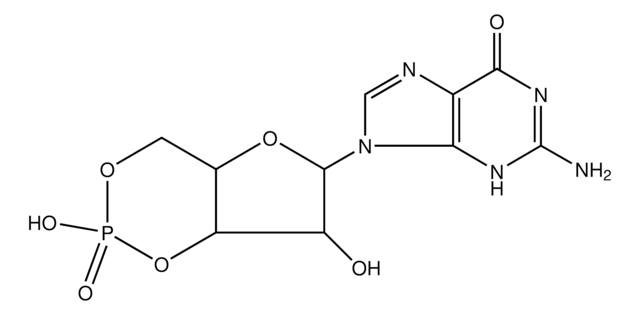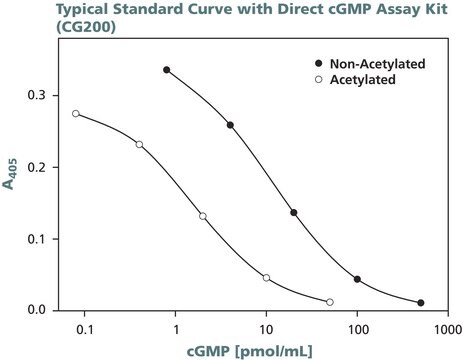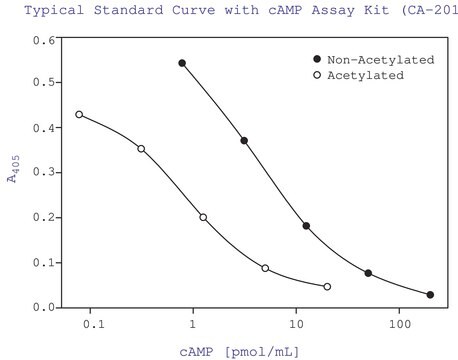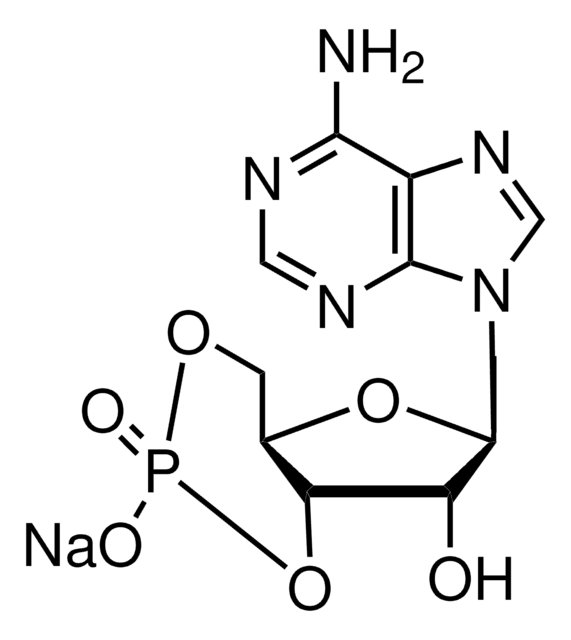Wszystkie zdjęcia(1)
Key Documents
CG201
cGMP Enzyme Immunoassay Kit
sufficient for 96 assays
Zaloguj sięWyświetlanie cen organizacyjnych i kontraktowych
About This Item
Kod UNSPSC:
12161503
NACRES:
NA.32
Polecane produkty
zastosowanie
sufficient for 96 assays
Poziom jakości
metody
ELISA: suitable
Warunki transportu
wet ice
temp. przechowywania
−20°C
informacje o genach
human ... PRKG1(5592)
Opis ogólny
cGMP Enzyme Immunoassay Kit is non-radioactive, competitive immunoassay for the quantitation of cyclic guanine monophosphate (cGMP) in biological fluids (serum, plasma, urine and saliva), tissue culture media samples or in samples containing very low concentrations of cyclic nucleotides. This kit uses a polyclonal antibody to cGMP to competitively bind cGMP or cGMP that has been covalently linked to an alkaline phosphatase molecule. The immunoassay is performed in a 96 well plate coated with anti-rabbit IgG antibody. The colored end product, produced by the addition of substrate to the wells, is read at 405 nm on a multiwell plate reader. The intensity of the color is inversely proportional to the concentration of cGMP present in the well.
Zastosowanie
Non-radioactive, competitive immunoassay for the quantitation of cGMP in biological fluids (serum, plasma, urine and saliva), tissue culture media samples, or in samples containing very low concentrations of cyclic nucleotides. This kit uses a polyclonal antibody to cGMP to competitively bind cGMP or cGMP that has been covalently linked to an alkaline phosphatase molecule. The assay is performed in a 96 well plate coated with anti-rabbit IgG antibody. The colored end product, produced by the additon of substrate to the wells, is read at 405 nm on a multiwell plate reader. The intensity of the color is inversely proportional to the concentration of cGMP present in the well.
cGMP Enzyme Immunoassay Kit has been used for the quantitative determination of cyclic guanine monophosphate (cGMP) concentration in parasite tissues and mouse aortic artery homogenates. It has also been used to assess the guanylate cyclase activity.
This page may contain text that has been machine translated.
Tylko elementy zestawu
Numer produktu
Opis
- Acetic Anhydride 1 x 1
- Assay Buffer 2 1 x 30
- cGMP-Alkaline Phosphatase Conjugate 1 x 5
- cGMP Assay Layout Sheet 1 x 1
- cGMP EIA Antibody Rabbit Anti-cGMP 1 x 5
- 5 Cycle Logit-Log Paper 1 x 1
- Cyclic GMP Standard 1 x 0.5
- Goat Anti-Rabbit IgG Coated 96 Well Microtiter Plate 1 ea
- p-Nitrophenyl Phosphate Substrate Solution 1 x 20
- Plate Sealer 1 ea
- Stop Solution 1 x 5
- Triethylamine 1 x 2
- Wash Buffer Concentrate 1 x 30
Zobacz wszystko (13)
Hasło ostrzegawcze
Danger
Zwroty wskazujące rodzaj zagrożenia
Zwroty wskazujące środki ostrożności
Klasyfikacja zagrożeń
Acute Tox. 2 Inhalation - Acute Tox. 3 Dermal - Acute Tox. 4 Oral - Eye Dam. 1 - Flam. Liq. 2 - Skin Corr. 1A - STOT SE 3
Organy docelowe
Respiratory system
Kod klasy składowania
3 - Flammable liquids
Temperatura zapłonu (°F)
12.2 °F - closed cup
Temperatura zapłonu (°C)
-11 °C - closed cup
Certyfikaty analizy (CoA)
Poszukaj Certyfikaty analizy (CoA), wpisując numer partii/serii produktów. Numery serii i partii można znaleźć na etykiecie produktu po słowach „seria” lub „partia”.
Masz już ten produkt?
Dokumenty związane z niedawno zakupionymi produktami zostały zamieszczone w Bibliotece dokumentów.
Klienci oglądali również te produkty
Inhibition of MPO (Myeloperoxidase) Attenuates Endothelial Dysfunction in Mouse Models of Vascular Inflammation and Atherosclerosis
Cheng D, et al.
Arteriosclerosis, Thrombosis, and Vascular Biology, 39(7), 1448-1457 (2019)
Identification of a novel Arabidopsis thaliana nitric oxide-binding molecule with guanylate cyclase activity in vitro
Mulaudzi T, et al.
Febs Letters, 585(17), 2693-2697 (2011)
Genistein from Flemingia vestita (Fabaceae) enhances NO and its mediator (cGMP) production in a cestode parasite, Raillietina echinobothrida
Das B, et al.
Parasitoloty, 134(10), 1457-1463 (2007)
David Cheng et al.
Arteriosclerosis, thrombosis, and vascular biology, 39(7), 1448-1457 (2019-05-03)
Objective- Inflammation-driven endothelial dysfunction initiates and contributes to the progression of atherosclerosis, and MPO (myeloperoxidase) has been implicated as a potential culprit. On release by circulating phagocytes, MPO is thought to contribute to endothelial dysfunction by limiting NO bioavailability via
Chard, T.
An Introduction to Radioimmunoassay and Related Techniques (1990)
Nasz zespół naukowców ma doświadczenie we wszystkich obszarach badań, w tym w naukach przyrodniczych, materiałoznawstwie, syntezie chemicznej, chromatografii, analityce i wielu innych dziedzinach.
Skontaktuj się z zespołem ds. pomocy technicznej







![Western Blocking Reagent, Solution solution, sufficient for 10 blots (11921673001 [100 cm2]), sufficient for 60 blots (11921681001 [100 cm2])](/deepweb/assets/sigmaaldrich/product/images/352/091/ef743cea-ccd8-44f1-8f3b-dec5a1e4f5d1/640/ef743cea-ccd8-44f1-8f3b-dec5a1e4f5d1.jpg)





